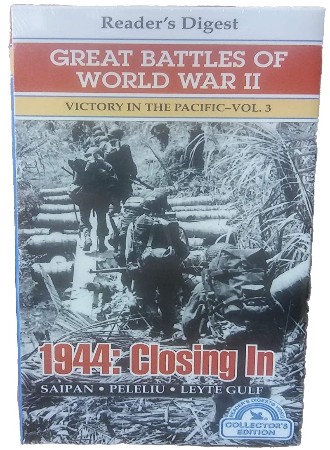
Great Battles of World War II, Victory in the Pacific - Volume 3 - 1944: Closing In 1987
Distributed by IVN Entertainment, Inc., 1390 Willow Pass Road, Ste. 900, Concord, CA 94520; 925-688-0833
Produced by The Reader's Digest Association Inc., Home Entertainment Division
Director n/a
VHS, b&, 88 min.
High School - Adult
History
Date Entered: 11/09/2018
Reviewed by Carol Lelonek, Health Sciences Library, University at Buffalo, Buffalo, NYGreat Battles of World War II, 1944: Closing In is a series of U.S. government film footage from World War II battles in the Pacific Theatre. The video is split into five segments, each dealing with specific confrontations. These include Manus and Los Negros; Saipan and Tinian; Peleliu and Angaur; the Battle of Leyte Gulf; and, Target Tokyo. Each battle film is accompanied by brief narration and realistic sound effects. Some clips are graphic in nature. Unfortunately, there is no prelude or dialog throughout to give the viewer a sense of what events led up to these confrontations or what was going on strategically or on the homefront. In this sense, those not conversant in WW II would have a difficult time following the chain of events.
Conversely, the use of actual film footage gives the viewer a real insight to the locations, soldiers, and military equipment involved. The narration, although brief, reaffirms the feelings of loyalty to defend one's nation and reminds us how dedicated the troops of the Army and Naval forces were. The tone of this narration also reaffirms the anger that America felt toward the Japanese after the attack on Pearl Harbor. The video is laced with dated slang terms and descriptions. It is also laced with grim reminders that war is hell and that by the Battle of Leyte over 250,000 Japanese were killed, or that some U.S. soldiers visit to the Island of Peleliu was for eternity and not just a few hours.
The audiences that would benefit most from this video are college-level history students, World War II and history buffs, and adults who served in the War and their families.